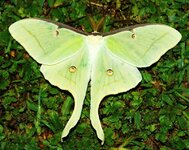Tn Gizmo
Sr. Member
- Sep 4, 2007
- 291
- 12
- Detector(s) used
- Compass 77B ; whites 6000D ; Garrett Master Hunter CX w/Treasure Hound (two box); Minelab Exp. II
Actias luna, commonly known as the Luna Moth, is a lime-green, Nearctic Saturniid moth in the family Saturniidae, subfamily Saturniinae. It has a wingspan of up to four and a half inches, making it one of the largest moths in North America. They have long, tapering hindwings, which have eyespots on them in order to confuse potential predators.
Males have more prominent eyespots where the female’s are more muted. Many people incorrectly call them “lunar” moths vice “luna”.In the southern United States, where we are, there can be as many as three generations in one season. These are spaced every eight to ten weeks beginning in March.Female Luna Moths lay 100–300 eggs, 4–7 eggs at a time, on the underside of leaves, and they incubate for eight to thirteen days.Although rarely seen due to their very brief (1 week) adult lives, Luna Moths are considered common.As with all Saturniidae, the adults do not eat or have mouths. They emerge as adults solely to mate, and as such, only live approximately one week.
Males have more prominent eyespots where the female’s are more muted. Many people incorrectly call them “lunar” moths vice “luna”.In the southern United States, where we are, there can be as many as three generations in one season. These are spaced every eight to ten weeks beginning in March.Female Luna Moths lay 100–300 eggs, 4–7 eggs at a time, on the underside of leaves, and they incubate for eight to thirteen days.Although rarely seen due to their very brief (1 week) adult lives, Luna Moths are considered common.As with all Saturniidae, the adults do not eat or have mouths. They emerge as adults solely to mate, and as such, only live approximately one week.




